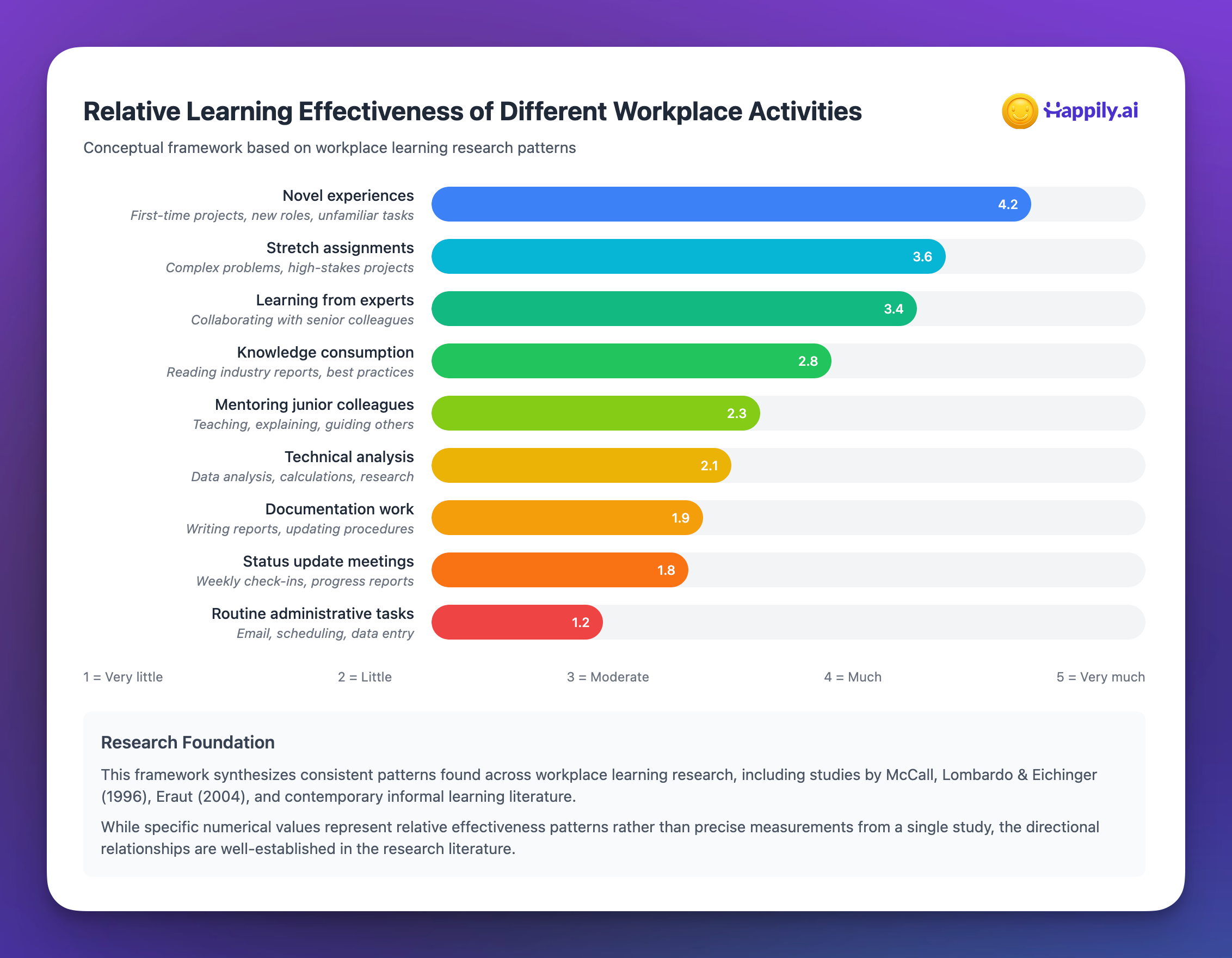Understanding what we lost when offices emptied—and why everything feels harder than it should
Every organization claims to be a "learning organization." Yet most leaders have no idea they just lost their primary development engine when they shifted to remote work. The symptoms are everywhere: decisions take longer than they should, problems that used to resolve through quick consultations now require formal meetings, and new hires struggle for months with challenges that experienced colleagues could address in minutes.
The culprit isn't remote work itself—it's the invisible learning infrastructure that disappeared overnight, taking with it the mechanisms that drive 70-90% of how people actually develop expertise in the workplace.
The Hidden Reality of How Learning Actually Happens
Here's what decades of research reveal about workplace learning: it doesn't happen where we think it does. The widely-cited 70:20:10 model, developed by McCall, Lombardo, and Eichinger in their groundbreaking research with 200 executives, found that only 10% of learning could be traced back to formal training programs (McCall et al., 1996). The other 90% came from informal experiences and social interactions.
More recent studies suggest even more extreme ratios. Research across Dutch organizations shows workers spending the vast majority of their learning time informally—through spontaneous conversations, observing colleagues, and collaborative problem-solving sessions—with only a small fraction coming from the formal training programs that HR departments measure and promote (van der Heijden et al., 2009).

When offices emptied in March 2020, we didn't just lose water cooler chats. We lost our learning infrastructure.
Microsoft's comprehensive analysis of 122 billion employee interactions during COVID revealed the precise mechanisms of this breakdown: teams became more siloed, cross-functional relationships withered significantly, and while meeting time increased 2.5x globally, meaningful knowledge transfer collapsed (Yang et al., 2022). We confused communication volume with learning effectiveness, adding traffic without building the trust and relationships that drive development.
The Science of Tacit Knowledge Transfer
The real crisis lies in what cognitive scientists call tacit knowledge—the invisible expertise that separates good performers from great ones. Michael Eraut's seminal research in workplace learning demonstrates that tacit knowledge represents the majority of what drives performance, yet it can only be transferred through direct social interaction and shared experiences (Eraut, 2004).
Tacit knowledge isn't information you can Google, prompt an AI with, or find in your company's knowledge base. It's the pattern recognition developed through thousands of micro-observations. It's knowing when to trust your instincts over the data, how to read between the lines in client conversations, which shortcuts actually work under pressure, and why some approaches fail even when they look right on paper.
Victoria Marsick and Karen Watkins' research identifies this informal learning as fundamentally experiential, non-routine, and often triggered by unexpected challenges or "jolts" in the work environment (Marsick & Watkins, 2001). Unlike formal training's structured curricula, informal learning emerges through situated experiences within specific organizational contexts.
Consider the difference between explicit and tacit knowledge in practice:
Explicit Knowledge: A new sales representative can learn product features from documentation, pricing structures from spreadsheets, and objection-handling scripts from training materials. An engineer can follow debugging protocols from a handbook.
Tacit Knowledge: But sensing when a prospect is genuinely interested versus being polite requires watching experienced colleagues navigate hundreds of conversations, observing subtle cues, and gradually developing intuition that can't be taught in training sessions. Similarly, developing a sixth sense for where bugs typically hide, recognizing which symptoms connect in unexpected ways, or knowing when to abandon standard processes comes from shared problem-solving experiences and real-time mentoring.
Research from Dublin City University's virtual internship studies crystallizes this challenge: "90% of knowledge on which performance in real-world settings is based is tacit knowledge"—embedded in people's heads and best shared through socialization (Billett, 2014). Digital environments successfully transfer explicit, codified knowledge through documents, videos, and structured content. But they fail catastrophically at tacit knowledge transfer.
The COVID Learning Parallel We're Ignoring
We have compelling parallel evidence for this breakdown, but most organizations are ignoring it.
During COVID-19, students experienced massive learning losses despite unprecedented investment in digital education technology. A comprehensive meta-analysis of 42 studies across 15 countries found students lost approximately 35% of a normal school year's learning progress (Donnelly & Patrinos, 2021). The pattern was revealing and directly applicable to workplace learning.
Reading skills held up reasonably well because students could practice independently with books and written materials. Mathematics suffered severely because it requires sequential skill building, immediate feedback, and collaborative problem-solving—exactly the type of learning that resists digital transfer.
Similarly, workplace skills requiring progressive mastery, creative problem-solving, or contextual judgment show comparable vulnerability. The difference is crucial: students received test scores showing their learning had stagnated. Workers don't get "tested" on tacit knowledge acquisition. Instead, we feel it as daily friction—the persistent sense that everything is harder than it should be.
Stanford's Jeremy Bailenson identified four primary causes of "Zoom fatigue" that directly impair learning: excessive close-up eye contact creating hyper-arousal, constant self-view increasing cognitive load, reduced mobility affecting cognitive performance, and the conscious effort required to process nonverbal cues normally handled subconsciously (Bailenson, 2021). Brain scans confirmed measurable physiological fatigue after 50-minute video conferences, explaining why digital interactions exhaust rather than energize participants.
When Networks Collapse, Learning Stops
Social network analysis reveals how remote work fundamentally altered knowledge flow patterns in ways that impede learning. Research by Granovetter on the "strength of weak ties" showed that breakthrough insights often come from distant connections rather than close colleagues—but these weak ties face particular challenges remotely (Granovetter, 1973).
Co-located teams demonstrate distributed knowledge sharing across multiple weak ties, while remote teams show centralized structures around key knowledge holders (Haythornthwaite, 2002). This centralization creates bottlenecks and single points of failure while reducing the cross-pollination that drives innovation and learning.
The breakdown occurs at multiple levels:
- Observational learning suffers without physical presence to notice subtle techniques and approaches
- Spontaneous problem-solving conversations disappear when every interaction requires scheduling
- Peripheral learning from overhearing conversations—a surprisingly important knowledge transfer mechanism—vanishes entirely
- Contextual understanding that emerges from witnessing complete work processes rather than curated presentations gets lost
At Happily.ai, our analysis of workplace interaction patterns shows this breakdown clearly. Organizations using our platform can track how knowledge-sharing behaviors and peer recognition patterns change in remote environments. We consistently observe decreased cross-functional collaboration and reduced informal knowledge transfer, even when formal meeting frequency increases.
The Neuroscience of Skill Acquisition
Recent neuroscience research provides unprecedented insights into why remote learning struggles persist. Adult brains maintain significant neuroplasticity throughout life, with workplace-specific training inducing measurable changes including increased cortical thickness and enhanced neural connectivity in task-relevant regions (Zatorre et al., 2012). But these changes require specific conditions that remote work often eliminates.
Spaced repetition enhances neural pattern similarity across learning sessions, improving long-term retention by up to 200%. The neuroscientific evidence shows that spaced learning creates stronger synaptic connections compared to massed practice, with benefits persisting for months (Cepeda et al., 2006). But this requires consistent interaction patterns and feedback loops that informal workplace learning naturally provided.
The neuroscience of habit formation reveals that skill automation involves a gradual shift from prefrontal (conscious) to striatal (automatic) control. Complex workplace skills typically require 66-254 days of practice to achieve automation, depending on complexity—and this transition strengthens most when practiced in consistent environmental contexts (Lally et al., 2010). Remote work's varied environments and reduced observational opportunities significantly slow this process.
Measuring the Invisible: What Organizations Miss
Most organizations have no way to measure informal learning, so they don't realize it's degrading. Traditional metrics—training completion rates, formal program attendance, knowledge test scores—capture only the visible 10% while missing the crucial 90%.
Organizations that successfully maintain learning and development track different indicators:
- Knowledge-sharing behaviors through peer recognition and collaboration patterns
- Problem-solving velocity by measuring how quickly issues get resolved
- Cross-functional relationship strength through communication network analysis
- Learning transfer effectiveness by tracking behavior change after development experiences
At Happily.ai, we've developed engagement analytics specifically designed to make informal learning visible. Our platform tracks real-time indicators of knowledge transfer: how often people seek and share feedback, peer recognition patterns aligned with company values, and the quality of development conversations. Organizations using these behavioral indicators report dramatically different outcomes—they can intervene when learning systems break down rather than discovering problems months later through engagement surveys.
The Competitive Advantage at Stake
The stakes couldn't be higher. Research shows that 50% of employees will need reskilling by 2025, and core skills are changing 40% every five years (World Economic Forum, 2020). In knowledge work, 85% of jobs that will exist in 2030 haven't been invented yet, making continuous informal learning essential for organizational survival.
Organizations with strong learning cultures achieve remarkable competitive advantages. Research by the Association for Talent Development shows they realize 218% higher income per employee compared to those with poor learning environments (ATD, 2020). They're 46% more likely to be industry leaders, have 24% higher profit margins, and demonstrate twice the employee retention rates.
Consider the compounding effect: when informal learning systems work effectively, knowledge transfers efficiently from experts to newcomers, innovation accelerates through cross-functional collaboration, and problems get solved faster through informal consultation networks. When these systems break down, organizations face the opposite spiral—knowledge hoarding, siloed thinking, and dramatically slower problem resolution.
Companies like Google exemplify this advantage through systematic attention to informal learning. Their Googler-to-Googler program handles 80% of all tracked training through peer learning, with investment of approximately $1,500 per employee annually yielding 6% increases in employee satisfaction and 10% productivity boosts (Google, 2019).
Recognition and Revelation
The organizations that recognize this invisible crisis and take action will build sustainable competitive advantages. The first step is measurement—making informal learning visible through behavioral analytics rather than relying on formal training metrics that miss the crucial 90%.
At Happily.ai, we're seeing organizations achieve remarkable results by focusing on the daily interactions that drive learning. Companies that consistently measure and respond to engagement patterns—tracking how knowledge flows through peer recognition, feedback quality, and collaborative problem-solving—report 48-point improvements in employee satisfaction scores, 22% increases in well-being measures, and 40% reductions in unwanted turnover.
But measurement alone isn't enough. Organizations must also redesign work patterns to preserve the informal learning opportunities that drive expertise development. This means strategic thinking about when and how to use in-person time, systematic attention to knowledge-sharing behaviors, and recognition that the future belongs to companies that solve tacit knowledge transfer in hybrid environments.
Conclusion: The Future Belongs to Learning-First Organizations
Your people are living with broken learning systems every day. They just don't realize why everything feels harder than it should be. The decision-making that used to happen through quick hallway conversations now requires formal meetings. The troubleshooting that occurred through casual consultation networks now gets escalated unnecessarily. The expertise that transferred naturally through observation and modeling now remains trapped in individual silos.
The question isn't whether your people are learning. It's whether you can see and measure the invisible 90% that makes the difference between competence and expertise. Organizations that recognize this challenge and systematically address it through behavioral measurement and intentional learning design will dominate the knowledge economy's next phase.
Those that continue relying on broken informal learning systems while investing only in formal training will find themselves increasingly unable to compete with organizations that understand how learning really works. The future belongs to learning-first organizations—and the window to build that capability is narrowing rapidly.
Ready to understand how learning is really happening in your organization? Discover how Happily.ai helps companies measure and improve the daily interactions that drive development through behavioral analytics and engagement insights. Learn more about making invisible learning visible.
References
Association for Talent Development. (2020). 2020 State of the Industry Report. ATD Press.
Bailenson, J. N. (2021). Nonverbal overload: A theoretical argument for the causes of Zoom fatigue. Technology, Mind, and Behavior, 2(1).
Billett, S. (2014). The standing of vocational education: Sources of its societal esteem and implications for its enactment. Journal of Vocational Education & Training, 66(1), 1-21.
Cepeda, N. J., Pashler, H., Vul, E., Wixted, J. T., & Rohrer, D. (2006). Distributed practice in verbal recall tasks: A review and quantitative synthesis. Psychological Bulletin, 132(3), 354-380.
Donnelly, R., & Patrinos, H. A. (2021). Learning loss during COVID-19: An early systematic review. Prospects, 51(4), 601-609.
Eraut, M. (2004). Informal learning in the workplace. Studies in Continuing Education, 26(2), 247-273.
Google. (2019). re:Work - Guide: Set learning and development goals. Retrieved from https://rework.withgoogle.com/
Granovetter, M. S. (1973). The strength of weak ties. American Journal of Sociology, 78(6), 1360-1380.
Haythornthwaite, C. (2002). Strong, weak, and latent ties and the impact of new media. The Information Society, 18(5), 385-401.
Lally, P., Van Jaarsveld, C. H., Potts, H. W., & Wardle, J. (2010). How are habits formed: Modelling habit formation in the real world. European Journal of Social Psychology, 40(6), 998-1009.
Marsick, V. J., & Watkins, K. E. (2001). Informal and incidental learning. New Directions for Adult and Continuing Education, 2001(89), 25-34.
McCall, M. W., Lombardo, M. M., & Morrison, A. M. (1996). The career architect development planner. Lominger.
van der Heijden, B. I., Boon, J., van der Klink, M. R., & Meijs, E. (2009). Employability enhancement through formal and informal learning: An empirical study among Dutch non‐academic university staff members. Career Development International, 14(6), 453-474.
World Economic Forum. (2020). The Future of Jobs Report 2020. World Economic Forum.
Yang, L., Holtz, D., Jaffe, S., Suri, S., Sinha, S., Weston, J., ... & Teevan, J. (2022). The effects of remote work on collaboration among information workers. Nature Human Behaviour, 6(1), 43-54.
Zatorre, R. J., Fields, R. D., & Johansen-Berg, H. (2012). Plasticity in gray and white: neuroimaging changes in brain structure during learning. Nature Neuroscience, 15(4), 528-536.









